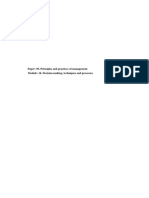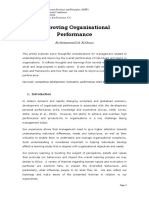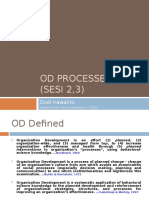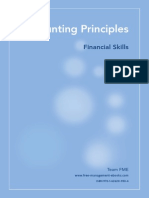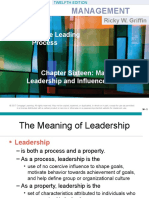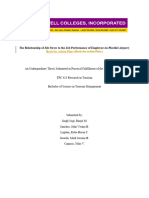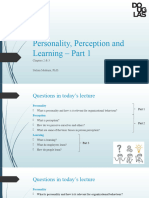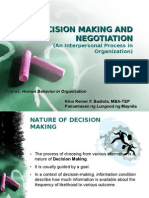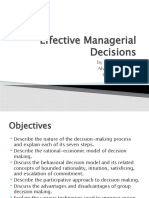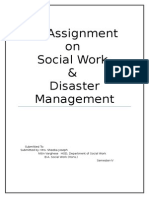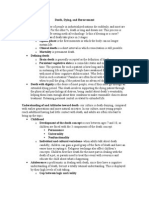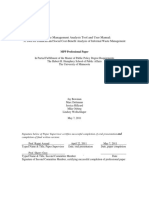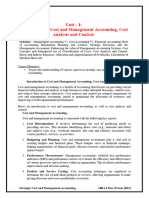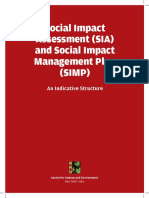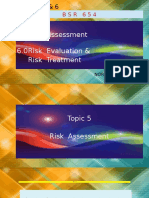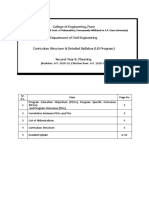Decision Making:
Levels and
Methods
Presented by Nitin Varghese
�Outline
Introduction to Decision Making
Types of Decisions
Decision Making Process
Constraints in Decision Making
Methods of Decision Making
�Introduction to Decision Making
Decision-making can be regarded as the
cognitive process resulting in the selection of a
belief or a course of action among several
alternative possibilities.
Decision-making is one of the central activities
of management and is a huge part of any
process of implementation.
�Introduction to Decision Making
Decision making can be defined concisely as:
Decision making is the process of making a
choice between a number of options and
committing to a future course of actions.
�Introduction to Decision Making
Process
Decision making is a process with several
stages. These combine to produce effective
outcomes. More complex or important
decisions are best made after a series of steps
are taken.
�Introduction to Decision Making
Choices
Decision making relies on numerous inputs and
a range of factors.
Inputs include the experience, knowledge,
common sense and judgment of the decision
maker of an organization, and possibly that of
others involved in the decision.
Choices are typically made within constraints,
that provide the boundaries within which
decisions have to be made.
6
�Introduction to Decision Making
Actions
Decision, are pointless without action. Decision
making is about the future, about looking
forward. Actions have consequences, both
intended and unintended. The consequences
can be detrimental or favourable to the
objectives.
A plan to eliminate or limit the adverse effects,
and capitalize on favourable consequences
must be thought of.
7
�Types of Decisions
Decision-making takes place at all levels of a
business or organization.
The Board of Directors/Director may make the
grand strategic decisions, managers may make
the more tactical decisions, but ordinary
employees are increasingly expected to make
decisions about the conduct of their own tasks,
responses to customers and improvements to
business practice.
8
�Types of Decisions
Strategic Decisions:These affect the long-term
direction of the business, the major long-term
decisions that point the direction for the
company. Senior staff on the entrepreneurship
level, such as the executives or VPs, makes
these decisions as they carry risk for the
business as a whole.
Examples: Which products are developed,
which new markets or countries to expand to,
review and deciding salaries and benefits paid
to the staff.
�Types of Decisions
Tactical Decisions. These are medium-term
decisions about how to implement strategy eg
what kind of marketing to have, or how many
extra staff to recruit. Regular and short-term
decisions normally made by middle
management.
Examples: Decisions about pricing strategy or
recruitment.
10
�11
�Types of Decisions
Operational Decisions. These are short-term
decisions (also called administrative decisions)
about how to implement the tactics eg which
firm to use to make deliveries. These are made
by junior managers, which dictate the everyday
actions and operations of the employees.
Usually, these decisions affect the immediate
time-span.Examples: How long workers break
for, which snacks to buy, or dealing with
customer complaints and suggestions.
12
�Decision Making Process
Outline your goal and outcome.
Gather data.
Develop alternatives (i.e., brainstorming)
List pros and cons of each alternative.
Make the decision.
Immediately take action to implement it.
Learn from and reflect on the decision.
13
�Decision Making Process
The 6 C's of Decision making
Construct: A clear picture of what exactly must
be decided
Compile: A list of requirements that must be
met.
Collect: Information on alternatives that meet
reqiurements
14
�Decision Making Process
Compare: Alternatives that meet your
requirements.
Consider: What the weaknesses and threats
associated with each alternative
Commit: To a decision/alternative and follow
through with it.
15
�Constraints of Decision Making
Internal Constraints
These are constraints that come from within the
business itself.
- Availability of finance. Certain decisions will
be rejected because they cost too much
16
�Constraints of Decision Making
- Existing Business Policy. It is not always
practical to re-write business policy to
accommodate one decision
- Peoples abilities and feelings. A decision
cannot be taken if it assumes higher skills than
employees actually have, or if the decision is so
unpopular no-one will work properly on it.
17
�Constraints of Decision Making
External Constraints: These come from the
business environment outside the business.
- Competitors behaviour, and their likely
response to decisions your business makes
- Lack of technology
- Economic climate
18
�Decision Making Methods
1. Cost Benefit Analysis
Cost-benefit analysis (CBA) is a worldwide
used technique in decision making. CBA
evaluates the costs and benefits of the
alternatives on monetary basis. Recently,
attempts have been made to incorporate the
environmental impacts within CBA to
improve the quality of environmental
decision making
19
�Decision Making Methods
2.Elementary methods These elementary
approaches are simple and no computational
support is needed to perform the analysis
These methods are best suited for problems
with a single decision maker, few alternatives
and criteria that is rarely characteristic in
environmental decision making
20
�Decision Making Methods
2.1 Pros and cons analysis:
Pros and cons analysis is a qualitative
comparison method in which good things (pros)
and bad things (cons) are identified about each
alternative. Lists of the pros and cons are
compared one to another for each alternative.
The alternative with the strongest pros and
weakest cons is preferred.
21
�Decision Making Methods
2.2 Maximin and maximax methods: The
maximin method is based upon a strategy that
tries to avoid the worst possible performance,
maximizing the minimal performing criterion.
The alternative for which the score of its
weakest criterion is the highest is preferred.
The maximin method can be used only when all
criteria are comparable so that they can be
measured on a common scale, which is a
limitation.
22
�Decision Making Methods
2.3 Conjunctive and disjunctive methods These
methods require satisfactory rather than best
performance in each criterion. The conjunctive
method requires that an alternative must meet
a minimal performance threshold for all criteria.
The disjunctive method requires that the
alternative should exceed the given threshold
for at least one criterion. Any alternative that
does not meet the conjunctive or disjunctive
rules is deleted from the further consideration.
23
�Decision Making Methods
2.4 Lexicographic method In the lexicographic
method criteria are ranked in the order of their
importance. The alternative with the best
performance score on the most important
criterion is chosen. If there are ties with respect
to this criterion, the performance of the tied
alternatives on the next most important criterion
will be compared, and so on, till a unique
alternative is found
24
�Decision Making Methods
Other major methods:
-Multi-attribute Utility Theory (MAUT) methods
-The ELECTRE methods
- The PROMETHEE methods
- Group decision making
- Sensitivity analysis
Sourcehttp://academic.evergreen.edu/projects/bdei/documents/decisionmakingmethods.pdf
25

